How Automation Will Transform Medical Billing Roles by 2027
Automation is no longer a prediction in medical billing—it’s already reshaping the industry. By 2027, over 70% of billing tasks will rely on AI-enabled automation, redefining how professionals manage claims, audits, and compliance. This evolution is forcing certified billers to shift from repetitive data entry toward high-value tasks such as revenue cycle optimization, denial prevention, and strategic analytics. For those with a Medical Billing and Coding Certification, understanding how automation transforms workflows isn’t optional—it’s the roadmap to long-term employability. This article explores the key technologies, roles, and strategies shaping the billing landscape of 2027.
1. From Manual Processes to Smart Revenue Cycles
For decades, billing relied on manual keying and reactive correction, leading to burnout and revenue leakage. Automation has flipped this model. Tools integrated through platforms like Epic, Cerner, and Athenahealth now combine AI, robotic process automation (RPA), and predictive analytics to ensure clean claims before submission.
Hospitals using AI-assisted billing—documented in the Comprehensive Guide to CMS Compliance for Medical Coders—report a 32% drop in claim rejections and a 40% boost in staff productivity.
Meanwhile, predictive coding solutions referenced in the Maximizing Revenue Through Accurate Modifier Application post identify potential errors before submission, minimizing payer delays.
Automation also frees billers from administrative overload, enabling focus on patient communication, payer negotiation, and audit strategy—roles impossible to automate entirely. This transition transforms medical billing into a strategic financial discipline rather than clerical work.
2. Automation Tools That Are Rewriting Billing Workflows
The most transformative automation tools go beyond macros and templates. Platforms such as R1 RCM, Olive AI, and Change Healthcare’s Smart Audit utilize Robotic Process Automation (RPA) to extract data, detect missing fields, and submit claims with minimal human input.
Professionals certified under the Medical Billing and Coding Certification in Nevada already study RPA workflows to prepare for hybrid billing roles. Similarly, Effective Use of Coding Exam Practice Tests highlights the analytical precision needed to supervise these systems.
RPA handles repetitive actions, while AI models learn payer patterns—predicting when claims will be denied or delayed. As automation gets smarter, the biller’s job shifts toward exception handling, financial forecasting, and compliance cross-checking.
3.Emerging Career Paths in the Age of Automation
By 2027, “medical biller” will no longer mean “data entry.” Instead, titles such as Automation Billing Analyst, Revenue Optimization Lead, and AI Audit Coordinator will dominate job listings. According to insights shared in the LinkedIn Q&A with Healthcare Leaders, 60% of billing managers now prioritize candidates with data and automation literacy.
Professionals completing the How to Transition from Medical Coder to Coding Auditor program are already seeing up to 20% salary growth after integrating RPA tools into their daily workflow. Those who combine AI fluency with regulatory understanding are positioned to lead automated billing departments by 2027.
4. The Compliance and Ethical Dimension of Automation
Automation doesn’t eliminate human accountability—it magnifies it. Every automated claim must still comply with CMS, HIPAA, and payer-specific requirements. As discussed in the Comprehensive Guide to CMS Compliance for Medical Coders, automation must operate under strict oversight to prevent mis-billing or fraud.
Moreover, as bots handle sensitive data, cybersecurity and ethical frameworks are becoming essential learning modules in the Expert Guide to ICD-11 Coding for Infectious Diseases and Pandemics. Ethical automation is not optional—it’s the new compliance standard.
The billers who stay indispensable are those who supervise algorithms with human judgment, ensuring AI acts within ethical and regulatory boundaries.
5. Upskilling for the Automated Future
The next generation of billing certifications will merge technical fluency with process intelligence. Courses like Medical Billing and Coding Certification in Oregon and Medical Billing and Coding Certification in Oklahoma now include automation labs where learners practice workflow optimization.
Upskilling paths focus on:
AI & RPA literacy – understanding automation logic
Data interpretation – converting outputs into business insights
Ethics & compliance – applying regulatory frameworks to AI-driven billing
By mastering these, coders can transition seamlessly into hybrid billing roles—where technology amplifies, not replaces, their expertise.
6. FAQs: Navigating Medical Billing Automation by 2027
-
No. Automation removes repetitive tasks but still requires certified billers for oversight, auditing, and compliance validation.
-
Start with RPA tools like UiPath and Alteryx, which are integrated in the Effective Coding Exam Practice Guide.
-
Yes. Those with automation certifications earn 12–18% more, especially in roles combining billing and analytics.
-
Follow CMS audit guidelines from Comprehensive CMS Compliance Guide and validate AI-generated claims manually before submission.
-
Data errors due to unsupervised automation or incorrect bot logic. This is addressed in the Reddit AMA Career Advice from Billing Entrepreneurs.
-
Automation-centric ones offered by AMBCI and hybrid programs such as Medical Billing and Coding Certification in North Dakota.
-
Build cross-disciplinary expertise in data, compliance, and technology, leveraging AMBCI’s training network.


